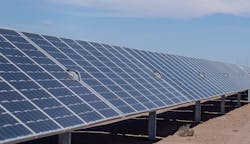Wholesaler Guzman Energy secures Sonnedix Solar Fountain in Colorado
Electricity wholesaler Guzman Energy has signed a long-term power purchase agreement to finance the output of a future 110-MW solar photovoltaic project in Colorado.
The deal with Sonnedix secures 100 percent of the renewable energy generated by the coming Solar Fountain site in El Paso County. The Solar Fountain, expected to be operational in 2025, could produce more than 300,000 MWh of carbon-free electricity during its first year of generation, according to Sonnedix.
Now that that the investment is secured, global renewables firm Sonnedix will develop, build, operate and maintain the Solar Fountain facility. This is the company’s first PPA in Colorado.
Denver-based Guzman Energy will be the offtaker and incorporate the electricity generated into its power portfolio for its customers including cooperatives, municipal utilities and tribes. El Paso County is one of Colorado's most populous countries and includes Colorado Springs.
“Sonnedix Solar Fountain is a great strategic fit for the Guzman Energy power portfolio as we look to build and purchase power generation with the right economic and environmental characteristics,” said Guzman Energy CEO Christopher Miller. “Guzman Energy wholesale power customers look to us for affordable and stable power pricing, reliability, and clean energy.”
Three years ago, Colorado Governor Jared Polis signed a series of clean energy bills aimed at helping the state reach a goal of 100 percent renewable electricity by 2040.
In the U.S., utility-scale wind, solar and hydro power account for close to 20 percent of the nation’s electricity generation resource mix, according to the federal Energy Information Administration. Along with nuclear, that would bring the total low and carbon-free electricity portion to nearly 40 percent, with the rest mainly gas and coal-fired power.
Overall, U.S. solar energy installed capacity has now reached more than 135 GW (direct current before inversion to alternate current in the main grid), according to the Solar Energy Industries Association. Colorado ranks somewhere outside the top 10 of states with installed solar capacity, while California is No. 1.
About the Author
Rod Walton, EnergyTech Managing Editor
Managing Editor
For EnergyTech editorial inquiries, please contact Managing Editor Rod Walton at [email protected].
Rod Walton has spent 17 years covering the energy industry as a newspaper and trade journalist. He formerly was energy writer and business editor at the Tulsa World. Later, he spent six years covering the electricity power sector for Pennwell and Clarion Events. He joined Endeavor and EnergyTech in November 2021.
Walton earned his Bachelors degree in journalism from the University of Oklahoma. His career stops include the Moore American, Bartlesville Examiner-Enterprise, Wagoner Tribune and Tulsa World.
EnergyTech is focused on the mission critical and large-scale energy users and their sustainability and resiliency goals. These include the commercial and industrial sectors, as well as the military, universities, data centers and microgrids. The C&I sectors together account for close to 30 percent of greenhouse gas emissions in the U.S.
He was named Managing Editor for Microgrid Knowledge and EnergyTech starting July 1, 2023
Many large-scale energy users such as Fortune 500 companies, and mission-critical users such as military bases, universities, healthcare facilities, public safety and data centers, shifting their energy priorities to reach net-zero carbon goals within the coming decades. These include plans for renewable energy power purchase agreements, but also on-site resiliency projects such as microgrids, combined heat and power, rooftop solar, energy storage, digitalization and building efficiency upgrades.

